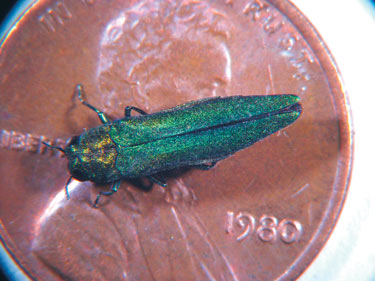
The story of invasive species goes all the way back to the earliest stages of human development, when bands of hominids dispersing from Africa carried with them the crumbs, seeds and eggs of whatever ecosystems they happened to be passing through. And you can be sure that, along with silk and spices, Marco Polo’s camels transported disease-ridden fleas between Europe and Asia.
More recently, European settlers introduced all kinds of pathogens to North America. For example, wellmeaning immigrants brought with them berry bushes infected with a fungus that now threatens ancient trees high in the Rocky Mountains.
What has changed in recent decades is the speed at which new invaders are spreading, criss-crossing to and from every corner of the Earth in the age of jet travel and global trade. From ecosystem-killing quagga mussels in Lake Powell and parasitic mites in honeybee hives all the way to white-nose syndrome, which has wiped out millions of bats, invasive species are inexorably changing their new habitats in ways that can directly affect our daily lives.
That would, of course, include the emerald ash borer, a small metallic green bug that hitchhiked to North America in packing crates about 20 years ago and has already killed more than 150 million ash trees in the Midwest. With no predators to keep populations in check, forest experts say the insects may end up nearly wiping out most North American ash trees, including many of the ornamental specimens growing in Boulder.
The first ash borers were found in the city in September 2013 and a subsequent survey, completed in January, found the insects in neighborhoods throughout Boulder, creating grim prospects for the beloved and economically valuable shade trees. According to city forestry officials and other experts, the bugs will probably kill most trees without a direct application of pesticides.
“We’re probably going to lose a quarter of our hard-won urban forest,” says Kevin Marks, one of only nine board-certified master arborists in Colorado. And that forest didn’t come easily to start with, Marks adds, explaining that when the settlers arrived at the foot of the Rocky Mountains, it was all grass.
Nearly all the city’s pleasing shade trees are themselves invasive species of sorts and were hand-planted, watered and babied to help them survive the extreme conditions along the Front Range.
As city officials scramble to determine the extent of the infestation and to develop some kind of response plan, federal researchers are starting to pinpoint where the bugs first touched down and how fast they’re spreading. In a report published in May, Forest Service scientists said the ash borer probably established itself as early as the mid-1990s in southeast Michigan.
For the first few years, the insects spread slowly, at about two miles per year, says Frank Telewskim, a professor of plant biology at Michigan State University. But in an almost inevitable population explosion, the ash borers established satellite colonies and started to spread up to eight miles per year, clearly with some help from humans, because their natural rate of spread is only about two miles per year.
A combination of natural emerald ash borer dispersal and humanassisted movement of infested ash material, such as nursery trees, logs and firewood, likely led to formation of many satellite colonies and the rapid progression of ash mortality, said U.S. Forest Service entomologist Nate Siegert.
“There are three different options,” Marks says, adding that he just had his busiest winter in 20 years in the Boulder area, mainly on account of ash borer concerns.
“There’s soil injection, trunk spraying and trunk injection, which is the most effective, but there are still plenty of failures,” he says. “One of the big things is, you have to get ahead of it. If you’re in a preventive mode, it works.”
Once the trees are stricken, the prospects aren’t so good, he says, adding that trunk-injection seems to be the preferred treatment option. Not only is it most effective, but it minimizes potential side effects of the powerful pesticide by keeping it contained within the tree. And protection doesn’t come cheap. Treatment averages about $15-$225 per tree, and with nearly 100,000 ash trees in Boulder, and more than a million in Denver … well, you can do the math.
And like with any of our other tangled relationships with chemical solutions, the use of pesticides can quickly create a dependency.
“Once you start, you’re going to be doing it forever,” Marks says. “You can’t just treat the trees once and walk away. If you do, they’ll probably be killed by the bugs.”
In Asia, where emerald ash borer is native, trees have evolved to be able to resist the beetles. There are also natural predators, including parasitic wasps that keep ash borer populations in check. Federal and state forestry experts have experimented with some biological control techniques and have even released some natural predators in parts of the Midwest to assess how well they might work, but the answers are still several years in the future.
One might also think, why not start planting ash species from Asia that are resistant to emerald ash borers? But it’s never quite that easy. It turns out those trees are highly susceptible to North American bugs like the lilac ash borer, Marks says.
Perhaps the best thing urban planners and property owners can do is to break out of the “save the trees” mindset, he says, explaining that ash trees were adopted as urban trees after Dutch elm disease wiped out most North American elms.
“You’ve got to be thinking about the next phase of the landscape. We all want what we want in our yard, but we’re all just passing through,” he says, adding that maintaining tree diversity is probably the best way to protect against catastrophic events like the emerald ash borer outbreak. Given that maples and oaks are among the most widespread tree species globally, those varieties might be a good bet to hedge against future insect invasions.
“Limiting any one tree species to 10 percent of your planting is a good general rule of thumb. If you really, really want to protect some ash trees, go ahead and use the pesticides. If not, invest in replanting,” he says.
Respond: [email protected]














